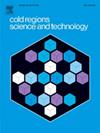Experiments on ice particle impact: a review
IF 3.8
2区 工程技术
Q1 ENGINEERING, CIVIL
引用次数: 0
Abstract
The behavior of ice particles impacting against a rigid surface is a topic that has gained more and more relevance in the field of transportation safety, particularly in the automotive and aerospace sectors. The present review outlines the various controlled experimental approaches used to study artificial ice particle collisions, describing the setup configurations, particle release mechanisms, and the selection of materials for impact surfaces. It also assesses fundamental studies that measure the coefficient of restitution (CoR or ) and the fragmentation regime of ice upon impact, clarifying how ice particles react when they strike a surface. The review also includes analytical and empirical formulas that describe the critical impact velocity, which determines the different impact outcomes, like bouncing, sticking, or fragmentation and fragmentation distribution of the ice particles. Lastly, it summarizes how particle size, temperature, and material properties affect the impact responses.
In addition, the review proposes a visual representation of the different models and how they compare. The visual representation highlights the differences between each model and the transition from elastic to plastic impact responses, and it is instrumental in understanding the conditions under which ice particles leave a residual mass on the impact surface. The insights gained from this review are vital for better understanding the impact of the ice particle phenomenon and mapping the state of the art in this branch of research.
求助全文
约1分钟内获得全文
求助全文
来源期刊

Cold Regions Science and Technology
工程技术-地球科学综合
CiteScore
7.40
自引率
12.20%
发文量
209
审稿时长
4.9 months
期刊介绍:
Cold Regions Science and Technology is an international journal dealing with the science and technical problems of cold environments in both the polar regions and more temperate locations. It includes fundamental aspects of cryospheric sciences which have applications for cold regions problems as well as engineering topics which relate to the cryosphere.
Emphasis is given to applied science with broad coverage of the physical and mechanical aspects of ice (including glaciers and sea ice), snow and snow avalanches, ice-water systems, ice-bonded soils and permafrost.
Relevant aspects of Earth science, materials science, offshore and river ice engineering are also of primary interest. These include icing of ships and structures as well as trafficability in cold environments. Technological advances for cold regions in research, development, and engineering practice are relevant to the journal. Theoretical papers must include a detailed discussion of the potential application of the theory to address cold regions problems. The journal serves a wide range of specialists, providing a medium for interdisciplinary communication and a convenient source of reference.
 求助内容:
求助内容: 应助结果提醒方式:
应助结果提醒方式:


